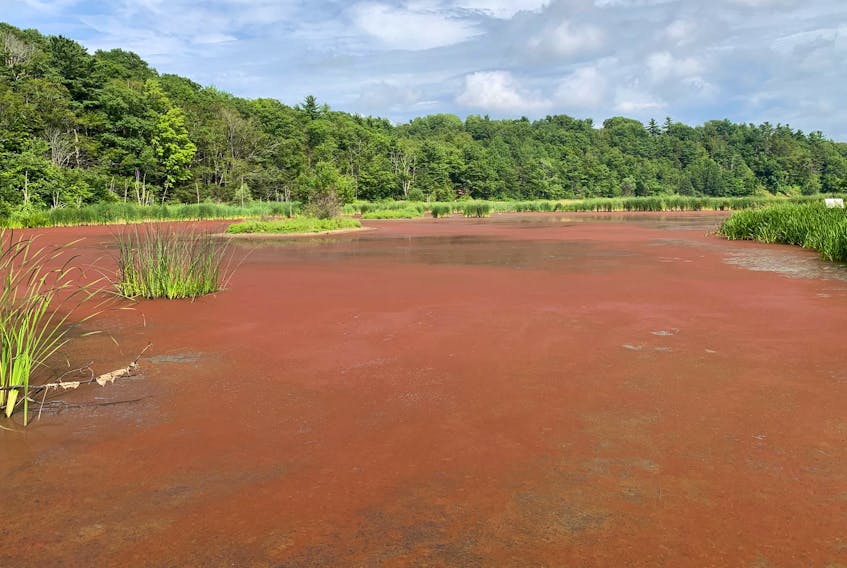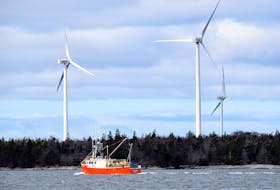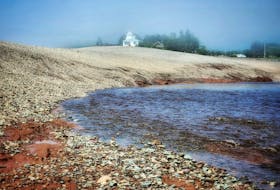An algae bloom at the Ducks Unlimited site in Kentville has prompted warning signs to go up at the popular walking trail.
Health Department officials believe that the bloom at Miners Marsh is blue-green algae, despite its reddish brown appearance.
“That’s one of the tricky parts of blue-green algae, it doesn’t always have to be blue or green,” said Linda Passerini, the manager of the environmental health program at the province’s Environment Department.
What they’re not sure of, though, is whether it is the toxin-producing type of the algae. They asked the town to put signs up warning people to keep their dogs out of the water as a precaution, as the toxins can cause a host of reactions in people and animals, including death.
Passerini said shallow water, stagnant water and warm water are the biggest contributers to algae blooms, and those conditions exist at the marsh.
“There’s not usually one cause. The bacteria that cause blue-green algae thrive in areas where the water is shallow, where it is warm and is slow-moving or stagnant,” she said.
The department was contacted by a member of the public who noticed the beginning of the bloom Wednesday. By Thursday afternoon, one of the ponds at the marsh was covered with the smelly algae.
“By the time it’s visible to us it’s already in a bloom, and with the warm temperatures and the slow moving water it can really amplify quickly,” Passerini said.
Nutrients from things like waterfowl droppings can also contribute, she said. Several dozen ducks and geese are at the site.
Once a bloom has appeared, all that can be done to remove it is to wait for it to die off, Passerini said.
“That’s naturally occurring, we can’t predict when that will happen.”
She said people need to avoid contact with the water, and not allow their pets to enter or drink the water, or eat any of the algae.
It can cause skin and eye irritation in humans, and fever, abdominal pain and diarrhea if swallowed or inhaled. It can cause similar reactions in dogs, but has been known to be fatal to animals if consumed.
Passerini said anyone who thinks they have seen the algae on a body of water should report it so the department can check it out. A key thing to look at is whether a mat of algae has formed on the surface of the water or a portion of the waterway. It can be blue, green, olive, turquoise or red.
Last week there was bloom reported on Lake Ainslie in Cape Breton. Passerini said she hasn’t heard of any others, but there may be some that have been addressed by the deparment’s district offices.
This is the time of year when the blooms are more likely to occur, she said.
She said anyone who comes into contact with a bloom should wash off with clean water. Boats should be rinsed before they go into another lake.
- Do not drink, swim, bathe, shower, or brush your teeth with the water.
- Do not allow children, pets, or livestock to drink or swim in the water.
- Use alternative water sources such as bottled, carted or tanked water, or call a water treatment specialist for help.
- Do not rely on jug or pitcher-type filtration systems. They do not make the water safe.
- Do not boil the water. Boiling water may release more toxins into the water.
- Do not cook with the water. Food may absorb toxins from the water.
- Do not water your vegetable garden with the water.
- You can wash dishes or other objects, as long as you rinse them with uncontaminated water and dry them thoroughly.
- Be careful with recreational water activities that generate sprays, such as motor-boating, because the toxins can be inhaled.
- When watering non-vegetable plants, avoid spray drift that may affect people and animals through inhalation or contact.
- Do not use herbicides, copper sulphate, or other algicides and do not treat the water with a disinfectant like chlorine (bleach). They may break open algae cells and release toxins.
- Be cautious about eating fish caught in water where blue-green algae blooms occur. Do not eat the liver, kidneys and other organs because the toxins can be stored here.
- If you have contact with a bloom, you should shower or wash yourself and any items that may have come in contact. If you get sick, seek medical attention
Source: Nova Scotia Department of Environment









